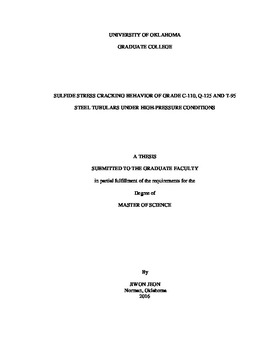| dc.description.abstract | Due to the expansion of hydrocarbon exploration into challenging sour oil and gas resources, the industry is now facing severe sour related corrosion problem. Sulfide Stress Cracking (SSC) is one of the detrimental types of corrosion which happens in sour environment. SSC quickly diminishes performance of downhole tubulars. The embrittlement induced by SSC causes failure of steel at a stress level, which is significantly lower than its yield strength. A premature failure of downhole tubulars impacts safety and operational issues during drilling, completion and production phases. Therefore, it is necessary to study the failure behavior of carbon steels used in sour environment.
The principal aim of this study is to understand mechanisms of SSC in the presence of CO2 and experimentally investigate the failure characteristics of API steels (T-95, C-110 and Q-125) exposed to high-pressure sour environment while subjected to a tensile load. Hence, to carry out the experimental investigation, minipipe specimens were cut and manufactured from API grade tubulars. During the test, a specimen was place in a SSC test cell (high-pressure autoclave), which was partially filled with 2% NaCl solution saturated with mixed gas containing CH4, CO2 and H2S. In the cell, the specimen was strained to create stress level, which is equal to 80% of its yield strength while maintaining the desired CH4, CO2 and H2S partial pressures for seven days to simulate the corrosive environment. The total pressure inside the specimen was kept at 6,000 psi while the outer pressure was held at 4,000 psi.
Impact of CO2 content of the gas phase on SSC is examined varying CO2 concentration (i.e. ratio of partial pressure of CO2 to the total pressure) from 0 to 40%. All tests were conducted at constant temperature (100°F) and H2S concentration (300 ppm). Temperature of 100°F is chosen for the CO2 investigation because SSC is known to occur at low temperature causing considerable change in mechanical properties of steel. Mechanical property changes occurring after exposure to the corrosive environment is used to quantify embrittlement of test specimens. Hence, mechanical properties of the specimens were measured after the exposure using Tensile Strength Testing (TST) apparatus and compared to the initial mechanical properties of an uncorroded clean specimen (baseline). After strength testing, microscopic examination was performed on broken specimens to assess embrittlement of the specimens based on crack features and shear deformation pattern.
According to the experimental results, SSC susceptibility of T-95 and C-110 grade steels is maximized at about 10% CO2 while that of Q-125 grade maximized at 25% CO2. The experiment reveals that tested carbon steels are safe to use without SSC concerns in environment containing H2S content of up to 300 ppm which is equivalent to 1.8 psi at total pressure of 6000 psi. However, presence of CO2 in sour environment significantly reduces the SSC resistance of steel especially when CO2 concentration is in the range of 10 to 30%. | en_US |
